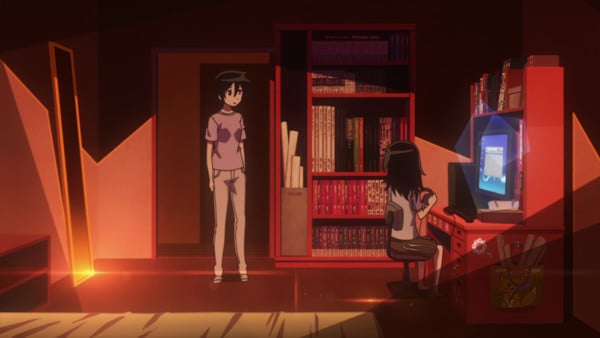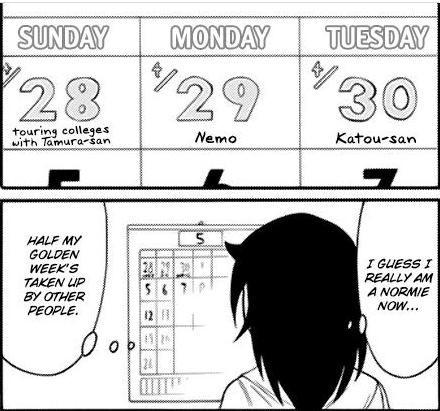From Introvert Cringe to Yuri Harem—Watamote Turns 10
by Norbert Daniels Jr.,
It's 2023, and anime about socially awkward girls are in. Komi Can't Communicate gave us a protagonist with such severe anxiety that she struggles to speak. For the main character of Bocchi the Rock!, merely being perceived is so painful that the anime visualizes her emotions by having her physical form glitch out of reality. The main goal for both protagonists is to push past their weaknesses to become popular and grow as human beings. These series are hits, but their success is owed to a 2013 manga that walked so they could run: WataMote.
No Matter How I Look at It, It's You Guys' Fault I'm Not Popular! (or WataMote, for short) is about the high school girl Tomoko Kuroki. She considered herself an ordinary, sociable person in middle school, but once she entered high school, she came to the horrible conclusion that she was hopelessly alone. Instead of blossoming into a popular high school heroine with radiant beauty and a fulfilling social life, she's barely a tier above a hikikomori. She has to fight for her life to order coffee without having a panic attack.
WataMote is often described as cringe humor, but that's putting it lightly. Even its biggest fans will tell you it is painful to watch. Beyond cringing at the relatable problems of trying and failing to socialize as an awkward teen, the series takes it further. For instance, there's a scene where Tomoko's mom walks in on her getting off to a recording of her favorite erotic visual novel voice actor degrading her.

Tomoko's personality was another sticking point that made this show hard to watch. Her lifestyle as a quasi-hermit who spent more time with visual novels than other humans had some… interesting effects on her personality. Her ideas of sexuality were pretty uncomfortable. According to Tomoko, "sexually harassing" (her words) her best friend Yuu is a silly joke. Or how in one episode, she tries to seduce her younger brother. And her insecurity has made her pretty judgmental, so she contemplates harsh insults to kids who have done nothing wrong to her. Even though I find the visceral agony of watching WataMote is what makes it so unique, it's also why it's a difficult anime to recommend. This is probably why it never got any more episodes besides its 13-episode first season and a single OVA.
But while the anime is no more, the manga has been steadily chugging along ever since. The anime adapted the manga up to volume 4, but as of this writing, there are 20 volumes. So what's Tomoko been up to for the last decade? Reading the manga beyond the anime, it immediately shifts away from everything that made it such an intimidating series to get through. The seeds of personal improvement that Tomoko sowed at the beginning of the series begin to sprout. She becomes frenemies with her schoolmate Kotomi Komiyama, a baseball otaku who has a lot of the same rough edges as Tomoko. And one by one, the cast grows. There have even been hints of romantic interest between Tomoko and her female friends. You'll hear fans claim the story's been transformed into a yuri harem manga.
The old Tomoko was a loner. New Tomoko has a friend roster in the double digits. Old Tomoko was apathetic about school. New Tomoko attends regular group study sessions and even went to a summer college prep camp with several friends. Old Tomoko revealed herself as a pathetic loser to her little cousin, who formerly looked up to her. New Tomoko has regained all that respect and more.

WataMote is no longer about mining cringe humor from social anxiety. It has become a journey of opening yourself up to the world and being transformed as a person, bit by bit. The story started with Tomoko in her first year of high school, and now she's in her senior year. She's had plenty of opportunities to stop and reflect on how different her life has become. My favorite moment is when she looks at her calendar and realizes she's gone from the girl who spends her entire school breaks cooped up in her room to someone with so many social engagements she hardly has time to be alone.

Moments like these make me reflect on my own life. I used to share a lot of traits with early Tomoko when I started following the series a decade ago. There was a period when I felt way too close to being a hikikomori or a NEET than I'd like to admit. But I'm happy to report that I've come a long way, just like Tomoko. The change inside me happened little by little until I woke up realizing that I had multiple jobs, rewarding physical and creative hobbies, and a growing number of deepening interpersonal relationships. This is a feeling I'm sure many of WataMote's longtime fans share, and seeing Tomoko go through the same journey alongside us makes this series so satisfying. And those who haven't entirely made it there yet may find hope in the series. If Tomoko can do it, so can you!
If you're an old WataMote fan or even someone who's never read or watched it, I encourage you to see what the series has been up to for the last ten years. Especially if you're a fan of Komi Can't Communicate or Bocchi the Rock!, you should see the series that paved the way. If you can push through the pain, you'll find your reward.
Norbert Daniels Jr. is a freelance writer. You can keep up with his work at NorbertDanielsJr.com
discuss this in the forum (12 posts) |